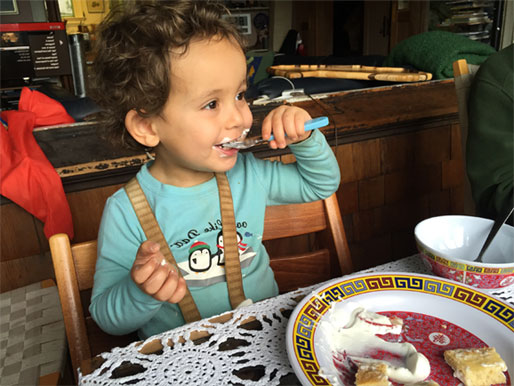Elizabeth A. Muller’s story
 As a working mom with two small children, a mid-morning phone call from daycare is not usually a good sign.
As a working mom with two small children, a mid-morning phone call from daycare is not usually a good sign.
Sure enough, the panicked voice on the other end of the line told me my 11-month-old son Asim was having an allergic reaction. By the time I arrived, he had progressed to full-blown anaphylaxis, a severe, life-threatening reaction to an unidentified food he had come into contact with.
Unfortunately, this wasn’t my first experience with food allergies. That frightening introduction had come a few years earlier when my daughter Layla had an anaphylactic reaction to playing with the shell of an egg. She would also turn out to be severely allergic to peanuts, tree nuts, fish, and buckwheat.
I had just been getting used to the idea of having one severely allergic child, but could I handle two?
Saying Goodbye to “Normal”
When I say allergies, I’m not talking about food sensitivities, intolerances or even celiac disease. I’m talking about a chemical [2] reaction to food that causes the immune system to overreact by producing antibodies that travel to cells which then release chemicals into the blood. It can result in death if not treated promptly with a shot of epinephrine. As any parent who’s seen what this kind of allergic reaction looks like knows, it’s nothing short of terrifying.
The most devastating part of a severe allergy diagnosis is that it’s usually followed by an admission that there is no treatment, no cure. Most allergists around the country tell us that the best thing we parents can do is practice a life of avoidance, where we learn to keep our kids away from the reaction-causing foods and either a) hope the child outgrows his/her allergies or b) learns to live safely with them.
It might sound easy enough on the surface, to simply avoid peanuts, eggs, dairy, or any other food they were allergic to, but for my children, and the millions like others, it would mean no chance for a “normal” life. I was terrified to think of a future in which Layla would have to ask her boyfriend what he had for dinner before she could kiss him. For Asim, who was allergic to 41 foods, including milk, it would mean almost complete social exclusion. I couldn’t even take him with me to a coffee shop, where milk is wafting through the air. Forget eating in a restaurant. Even sending him to school could be a potentially fatal event.
The Good News: There is an Effective Medical Treatment
When I was done crying for my children and our family life, I decided to take an independent look into food allergy treatments.
A quick Google search for “food allergy treatment” or “food allergy cure” produces results from leading organizations such as the U.S. National Library of Medicine, Food Allergy Research and Education (FARE) and even the American Academy of Allergy Asthma and Immunology that claim there is no “cure” for food allergies and that standard practice is to avoid the allergens. I could find no relevant books and all the scientific papers were behind expensive paywalls.
So I turned to Facebook support groups for parents with children who have food allergies. And eventually, I discovered that there are, indeed, a series of treatments called “desensitization therapies” already in use that essentially “cure” food allergies. In fact, thousands of kids and adults with severe food allergies have used these treatment programs to allow themselves to eat the foods they were allergic to, and go on to live “normal,” less restricted lives.
Fortunately for our family, one of the most respected food allergy treatment doctors in the country had a practice only an hour’s drive from our home. I chose to switch our allergy care to Dr. Jain and we started an intense and rewarding journey of food allergy treatments for my children.
Today, thanks to these desensitization therapies, Layla and Asim (now 10 and 7, respectively) are both free to eat their former allergens and live “normal” lives. When they graduated from their treatment programs, we took a family trip to Disneyland and celebrated our newfound freedom with food, fun and socialization, something that would have been unthinkable before.